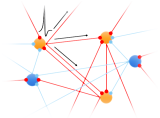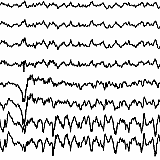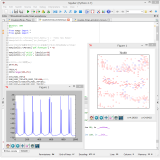研究内容 Research
研究の目標Research topics
私たちは、脳の神経活動の解析やそのコンピュータシミュレーションを通じて脳の情報処理の仕組みを解明しようとしています。そして、脳の情報処理の仕組みに基づく脳型の知的システムの構築し、社会課題解決へ応用することを目指しています。
脳の仕組みに基づくことで,今までコンピュータが出来なかったことを実現するだけではなく,同じ結果を得るにもエネルギー効率が良く省エネで,システムの一部が壊れても支障がでない仕組みが作れると考えています。
現在は、脳の仕組みにより近いスパイキングニューラルネットワークに関する研究や、社会課題解決の1つとして,災害対応のための衛星画像解析などの応用分野に取り組んでいます。
We aim to understand how the brain processes information by analyzing and simulating
neuronal activities in the brain and to apply our findings for solving social issues.
By using mechanisms inspired by how the brain processes information, we
believe that these mechanisms will not only achieve a new type of processing
that computers couldn't do before, but also achieve better energy efficiency
and the ability to keep working even if a part of a system fails.
Currently, we are also working to improve the performance of spiking neural networks, which process information in a
brain-like manner and to solve problems in data processing of satellite images for disaster management.
脳の情報処理メカニズムの解明に向けてFor Understanding Computation in the Brain
脳にはたくさんの神経細胞があり、互いにつながり、回路(ネットワーク)を作っています。
1つ1つの神経細胞は電気信号(活動電位)を発することができます。これらの信号は回路を通じて他の神経細胞へと送られており、信号のやり取りが生じています。さらに、その信号のやり取りによって、回路が変化することもあります(シナプス可塑性や神経新生など)。
そのため、常に同じ相手と同じように信号をやり取りしているのではありません。同じ大きさの信号でも、それを受け取る神経細胞の応答が変わることや、信号を受け取る神経細胞自体が変わることもあります。
そして、神経細胞の回路での信号のやり取りや回路の変化によって、脳は様々な機能を実現しています。例えば、私たちは見たこと、聞いたことを覚えることができますが、それは入力された情報によって神経細胞の回路が変化し、その変化が維持されることによって情報が保存されると考えられています。
そこで、神経細胞の回路でどのように信号のやり取りが行われているのか、どのように回路が変化するのか明らかにすることが、脳のメカニズムの解明に必要となるわけです。では、脳の中のこと(神経細胞の回路や信号のやり取りなど)をどうやって調べればよいでしょうか?
まず、脳の中で起きているニューロン間の信号のやり取りを計測することができれば、脳のメカニズムの解明につながる手がかりが得られます。また、コンピュータ上に神経細胞を再現し、脳と同じ人工的な回路を作ることができれば、様々な状況での回路の変化を調べることができ、これも脳のメカニズムの解明につながります(コンピュータシミュレーション)。
神経回路情報処理研究室では、脳から得られたデータの解析と脳内の神経ネットワークのコンピュータシミュレーションを通じて、脳内で行われている情報処理を解明する研究を行っています。
In the brain, many neurons are connected to each other and form circuits
(networks).
Each neuron can emit electrical signals (action potentials), and these
signals are mutually sent to other neurons through circuits. In addition,
circuits can change through signal exchange (e.g., synaptic plasticity
and neurogenesis). Neurons do not always exchange signals with the same
neurons in the same way. Even though the same signal is sent to a regular
neuron, the neuron may cause different activities. Moreover, other neurons
might receive the signals.
The brain performs various functions by exchanging signals and modifying circuits.
For example, we can remember what we see and hear, because the input information changes the circuits of
neurons, and the information is stored by maintaining the modification.
Therefore, it is necessary to elucidate how signals are exchanged in neuronal circuits and how these
circuits change in order to understand the mechanisms of the brain.
So, how do we elucidate the mechanisms of the brain? If we can measure
the exchange of signals among neurons, it will lead to the elucidation
of the communications among neurons in the brain. In addition, if we can
reproduce neurons and circuits on a computer (computer simulation), we
can investigate circuit changes in various situations.
In our Laboratory, we are conducting research aimed at elucidating information processing in the brain through data analysis and computer simulations of neural circuits.
脳の計測データの解析From Data Analysis of Neuronal Activities
脳の計測データの解析に関する研究として、運動に関係する脳の領域(運動野)と記憶に関係する脳の領域(海馬)から計測された電気信号を解析し、行動と記憶の関係を明らかにする研究があります。
We analyze electrical signals from brain regions related to movement (motor
cortex) and memory (hippocampus) to understand the relationship between
behavior and memory.
共同研究先から提供いただいた脳の計測データには、課題を行っている際の、脳のある神経細胞の回路で生じた電気信号が記録されています。その信号の中には、回路を構成する神経細胞が発した電気信号や、
多くの神経細胞の活動の集合的な信号が含まれています。その信号をよく調べると特徴的な波形が頻繁に現れることがあります。特徴的な波形が起きるタイミングを知ることで、脳の情報処理メカニズムの解明につながる手がかりとなることから、
課題のどういうタイミングで特徴的な波形が現れるのかを調べたりします。 Electrical recordings, obtained from an brain
during a task, are provided
by a joint research theam. The recordings include not only electrical signals
emitted by a single neuron but also collective signals of the activities
of many neurons.
If we analyze the recordings, we can detect typical waveforms in the signals frequently. It is
considered that the timings of the waveforms give us insights into the mechanism of information
processing in the brain. Therefore, as an approache of data analysis, we are investigating when these
waveforms occur during a task.
情報系の学科を志望する(に所属する)学生に向けて
For students who will major information science
脳の計測データは、時に膨大で、その解析にはコンピュータによる処理が必要不可欠です。
プログラミング、信号処理、パターン認識(機械学習)などの情報科学分野で学ぶ知識や技術は、神経細胞の活動データの処理につながります。もちろん、そのデータを扱うためには神経科学の知識も必要です。
We can obtain large amounts of data from the brain. Without the power of computers, it would be impossible to process it. Programming, signal processing, image processing, pattern recognition (machine learning), and other knowledge and skills you will learn in information science field may lead to the processing of neuronal activity data. Of course, You will need to learn about neuroscience to handle the data.
脳のコンピュータシミュレーションFrom Computer Simulation of the Brain
コンピュータシミュレーションに関する研究として、記憶に関係する脳の領域(海馬)が記憶を形成するメカニズムを明らかにする研究を行っています。 We aim to elucidate the mechanism of the memory formation by simulating the neuronal activities of the hippocampus which is a brain region involved in memory.

脳の海馬領域から計測された電気信号には特徴的な波形が含まれています。記憶と関係する特徴的な波形があることや、そのような波形が生じている際には神経細胞自体も特徴的な活動を生じることが分かっています。
そこで、神経細胞が発する特徴的な活動をコンピュータ上で再現します。その活動が神経細胞の回路の中でどのように伝わっているのか、そして、そのやり取りによってどのように回路が変化するのかを調べることで、海馬の記憶を形成するメカニズムの解明につながると考えています。
そのためには、対象とする脳の領域にある神経細胞、神経細胞同士のつながり、回路の変化の仕方などをコンピュータ上に再現するプログラムを作成することになります。再現の仕方には非常に簡略化した方法から、複雑な方法までありますが、完全に再現することは難しいです。しかし、完全ではないにせよ、コンピュータ上に再現することで、神経細胞同士のつながり方を変えたり、変化の仕方を変えたりといった、実際の脳の神経回路では難しい操作を加えて調べることができます。このような操作をコンピュータ上で行い、様々な状況での神経細胞の回路の信号のやり取りや回路の変化などを調べることで、本物の脳での神経細胞の回路での信号のやり取りや、回路の変化に関する手がかりを得ることができます。
Electrical recordings, obtained from the hippocampus, show a typical waveform.
When such a typical waveform occurs in the hippocampus, it also cause typical
activities in the region. It is reported that some typical activities are
related to memory formation. Thus, we reproduce the activities of neurons
during the typical waveform on a computer.
We can simulate how signals are exchanged and how these circuits change by activities in the artificial
circuits. We believe that the simulation will lead to the elucidation of the mechanism in the
hippocampus. To simulating the brain, we have to make a program that reproduces neurons, the
connectivities among neurons, the rule of circuit modification. Although there are very simplified and
complex ways to reproduce them, it is challenging to reproduce them completely even by complex methods.
However, by reproducing it on a computer, it is possible to manipulate
the circuit as we want, even if not completely. Manipulating its connectivity
and the modification rule is difficult in a real brain, but we can do them
in an artificial neural circuit. By performing such manipulations on the
artificial circuit and investigating signal exchanges and circuit changes
in various situations, we can obtain clues about the mechanism of information
processing in the brain.
工学部研究紹介にもコンピュータシミュレーションによる研究内容を紹介しています。 Click here for the infromation about our research fields in English
情報系の学科を志望する(に所属する)学生に向けて For students who will major information science
脳のコンピュータシミュレーションを行うためには、コンピュータ上に脳を再現しなくてはなりません。脳について多くのことを学び、プログラミング、数値計算などの知識や技術を活かすことで、コンピュータに脳の一部を再現させることができます。さらに、複数のコンピュータやCPUに処理を分担させる並列計算などの技術を用いることで、計算に時間がかかる複雑なことを効率的に再現することもできます。
In order to simulate the brain on a computer, it is necessary to reproduce
phenomena that occur in the
brain as a computer program.
By acquiring knowledge and skills in the field of information science, such as programming, numerical
analysis, along with neuroscience, you can make a computer program reproducing a part of the brain.
Furthermore, by using parallel computing, which distributes calculations in a program across many CPUs
and GPUs, you can efficiently run the simulation program.
脳の情報処理の応用Application of Neural Computation
脳の神経細胞の情報処理にヒントを得て作成されたニューラルネットワークは、近年、深層学習(ディープラーニング)と呼ばれるかたちで進展し、様々な分野へ応用されています。
脳の情報処理がもつ機能の中には、深層学習(ディープラーニング)が不得意とするものもあり、
脳の情報処理を応用することは、コンピュータの情報処理能力を進展させると考えられます。
深層学習(ディープラーニング)は、脳の神経細胞の情報処理にヒントを得ているものの、脳の神経細胞や回路の働きを模倣するものではありません。
一方、脳の神経細胞や回路の働きをより詳細に真似るようにして情報処理を実現しようとする試みとして、スパイキングニューラルネットワークがあります。
スパイキングニューラルネットワークは、脳のコンピュータシミュレーションのように、コンピュータ上に脳を再現し、それを何らかの問題を解かせるために利用します。
実際の脳の神経細胞の回路は、特徴的な構造になっていたり、特徴的な活動が生じていますが,このような特徴をうまくスパイキングニューラルネットワークに取り込むことで、性能の向上につながると考えています。
そこで、脳の構造や活動の知見を取り入れるスパイキングニューラルネットワークの改良を行っています。
また、さらに応用的な試みとして、深層学習(ディープラーニング)などの知識・技術を活用し、人工衛星によって撮影された画像の解析にも取り組んでいます。
多くの人工衛星が打ち上げられ、多くのデータが人工衛星から得られる状況が迫っています。これらのデータから様々な社会課題の解決につながるインテリジェンスを得るための研究も行っています。
具体的には、衛星データを利用した災害発生域の自動検出など、災害が発生した後の災害対応に役立つ情報を衛星データから得るための技術開発に取り組んでいます。
Neural networks, inspired by the information processing in the brain, have
made remarkable progress in recent years as deep learning. The technologies
have been applied across various fields.
Deep learning struggles with certain functions inherent to the information processing in the brain. We consider that the application of the functions advance the information processing of computers. Although deep learning takes inspiration from the information processing of the brain, it does not mimic the mechanism of neurons and circuits in the brain. In contrast, spiking neural networks aim to achieve information processing while more closely mimicking the mechanisms. The actual circuits in the brain exhibit typical structures and typical activities. We believe that successfully incorporating these features into spiking neural networks will enhance their performance. Therefore, we integrate the findings of brain structures and activities into spiking neural network.
Furthermore, we aim to solve various social problems by using the knowledge
and technology gained through our research activities, such as the development
of automatic satellite data analysis system.
情報系の学科を志望する(に所属する)学生に向けて For students who will major information science
脳の情報処理メカニズムの応用では、脳について多くのことを学び、それを機械学習(ニューラルネットワーク)に活かすことで、最終的に実世界の諸問題を解決するためのシステムの構築を目指します。その過程においては、プログラミング、信号処理、画像処理やパターン認識(機械学習)などの情報科学分野における知識や技術が必要となります。
As the application of information processing mechanisms of the brain, you may aim to build a system that
solves various problems in the real world. You can achieve this by leveraging a lot of knowledge and
skills in the field of information science and brain-inspired information processing.
各研究の具体的な内容については、研究業績をご参照ください。 For details on each research, please refer to our research publications.
Collaborationsコラボレーション
共同研究などでお世話になっている研究室や研究センターです。 These are the laboratories and research centers that we collaborate with in our research.TOPICSトピックス
2025年10月25日Oct. 25, 2025
中国支部連合大会で発表しましたPresentation at Joint Conference 2025
2025年06月14日Jun. 14, 2025
NLSC2025での発表Presentation at 2025 NLSC
2025年04月01日Apr. 1, 2025
新メンバー加入Welcoming new members
神経回路情報処理研究室 Lab. for Neural Circuit Comp.
〒755-8611
山口県宇部市常盤台2-16-1
山口大学工学部知能情報工学科
Tokiwadai 2-16-1, Ube-shi,
Yamaguchi, 755-8611, Japan
Yamaguchi University
准教授 佐村 俊和 Toshikazu Samura
Associate Professor
E-mail:
![]()
![]()
![]()
助教 タナヴィット ゲルドプラサットThanawit Gerdprasert
Assistant Professor
E-mail:
![]()
![]()
![]()